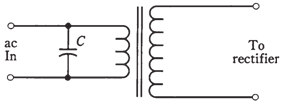Transient suppression:
The alternating current on the utility line is a sine wave with the constant RMS voltage near 117 V. But there are spikes, called as transients, lasting microseconds or milliseconds, which achieve peak values of hundred or even thousand volts.
Transients are created by sudden changes in load in a utility circuit. Lightning can produce them. Unless they are suppressed, they can destroy diodes in the power supply. Transients can befuddle the operation of sensitive equipment such as personal computers.
The easiest way to get rid of most transients is to place the capacitor of around 0.01 µF, rated for 600 V or more than this, across primary transformer. Commercially made transient suppressors are available. In the event of the thunderstorm locally, best way to protect equipment is to unplug it from wall outlet. If you have a personal computer, hi fi set, or other electronic appliance which you are fond of it's not a bad idea.

Figure A capacitor, C, in parallel with the primary of the transformer, helps suppress transients.